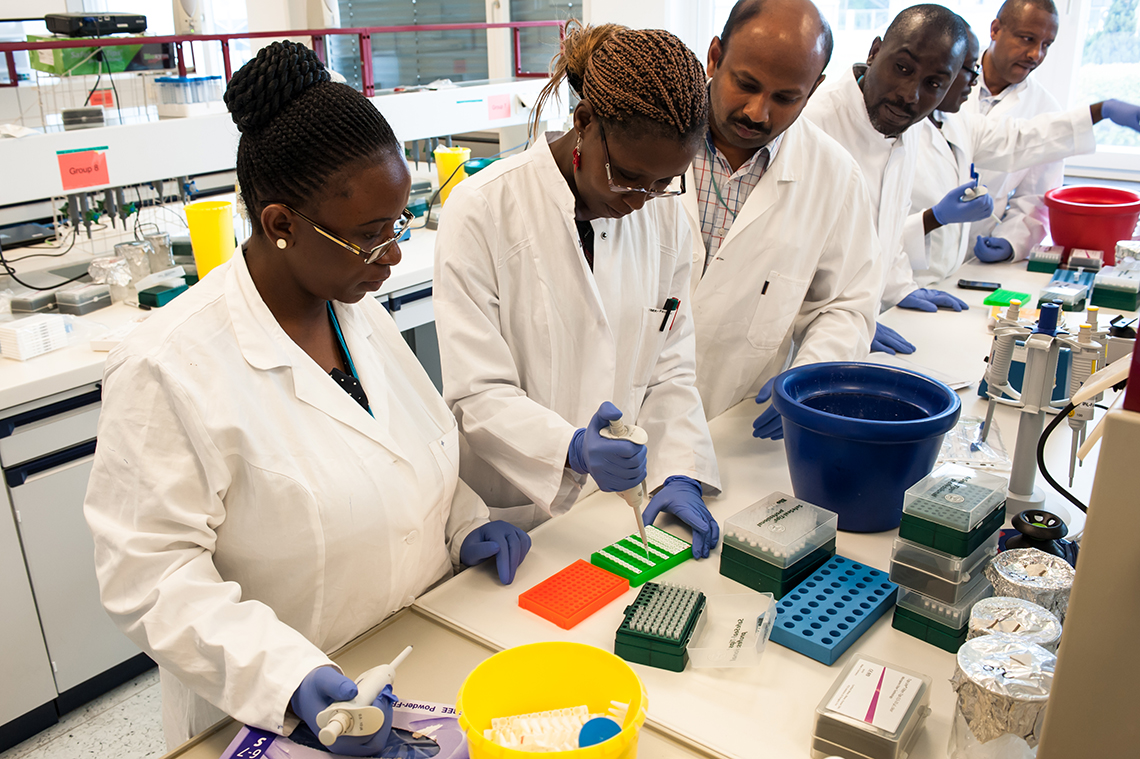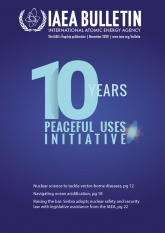
If you would like to learn more about the IAEA’s work, sign up for our weekly updates containing our most important news, multimedia and more.
Helping to Tackle the Spread of Zoonotic Diseases: The VETLAB Network
Elodie Broussard

Veterinary scientists receive hands-on training on test verification and validation for molecular diagnostic assays at the Seibersdorf laboratory. (Photo: IAEA)
Helping to tackle the spread of zoonotic disease: The VETLAB Network
The virus responsible for COVID-19, originating in animals, emerged in humans in late 2019 and upended the world as we know it. While it is the first disease in over a century to cause daily lives and economies worldwide to grind to a halt, it is not the first disease to cross from animals to people.
More than 60 per cent of diseases now affecting humans started in animals — and with improved surveillance and animal disease control, they could be stopped in their tracks. This is what underlines the importance of global initiatives like the Veterinary Diagnostic Laboratory (VETLAB) Network, through which veterinary labs exchange information, share best practices and support each other. The VETLAB Network is maintained by the IAEA, in partnership with the Food and Agriculture Organization of the United Nations (FAO), and is funded through the Peaceful Uses Initiative and the African Renaissance and International Cooperation Fund.
“Over the last eight years, the VETLAB Network has helped more than 60 countries to quickly detect and control animal and zoonotic diseases, including the Ebola virus disease, avian influenza and, most recently, COVID-19,” said Charles Lamien, an Animal Health Expert at the Joint FAO/IAEA Division of Nuclear Techniques in Food and Agriculture. “With diseases having no regard for borders, we have to work together to control their emergence, re-emergence and spread. The VETLAB Network provides an effective way to do that.”
The VETLAB Network, created in 2012, comprises 71 laboratories in 45 African and 19 Asian countries. It is now working to expand to Central and Eastern Europe, and Latin America and the Caribbean. The laboratories work with each other as well as with experts from the Joint FAO/IAEA Division to use nuclear, nuclear-derived and other methods for monitoring, early detection, diagnosis and control of diseases (see The Science below).
“ Thanks to IAEA support, we were able to control the outbreak within three months.
Quick response
Central to the VETLAB Network’s mission is to enable countries to quickly respond to disease outbreaks. It played a key part in dealing with the 2017 avian influenza outbreak in Africa. The disease threatened the US $1 billion poultry industry across the six countries it struck.
Through the Network, veterinarians at the laboratories of the affected countries rapidly received the most up-to-date procedures on how to deal with the outbreak, as well as necessary laboratory supplies, such as reagents and reference material for virus detection and characterization. By mid-2018, the outbreaks were rapidly controlled.
Ready to test
One important step in disease detection and control is to test samples from potentially infected animals or people as early as possible. When a country does not have the trained staff and equipment to test, the samples are sent to laboratories abroad, which can be expensive and time consuming.
The VETLAB Network has helped address these issues by supporting countries to establish testing capacities. These include effective quality management systems, which have led to international accreditation for some of the more advanced laboratories.
Fighting African swine fever
In 2018, when African swine fever began appearing in Asia, veterinarians from Africa had already shared their decades-long experience in dealing with the virus with their Asian counterparts through the VETLAB Network. This helped Asian countries set up effective detection and management strategies.
This preparatory work made it faster and easier for experts in Cambodia, Indonesia, the Lao People’s Democratic Republic, Mongolia, Myanmar and Viet Nam to use the emergency assistance provided by the IAEA’s technical cooperation programme. Malaysia and Thailand also received equipment for early detection and diagnosis.
In Mongolia, the outbreak affected more than 80 pig farms. As a result of the assistance provided through the VETLAB Network, only 3000 of the 28 000 pigs at risk had to be culled to control the spread of the disease. “Before the outbreak, several of our laboratory staff were trained by the IAEA, and we received equipment,” said Tserenchimed Sainnokhoi, Deputy Director of Mongolia’s State Central Veterinary Laboratory. “Thanks to IAEA support, we were able to control the outbreak within three months.”
ZODIAC
The decades of experience and collaboration through the VETLAB Network is now set to play a key part in the IAEA’s new Zoonotic Disease Integrated Action (ZODIAC) initiative. Launched in 2020 amid the COVID-19 global outbreak, ZODIAC aims to establish an international network of laboratories, building in part on the VETLAB Network, to provide a unified platform for pre-empting and preventing zoonotic disease outbreaks.
“It’s important to monitor what is going on in the animal kingdom — both in wildlife and livestock — and to act quickly on those findings before the pathogens jump to humans,” said Gerrit Viljoen, Head of the Animal Production and Health Section of the Joint FAO/IAEA Division.
THE SCIENCE
The enzyme-linked immunosorbent assay (ELISA) and the real time reverse transcription-polymerase chain reaction (real time RT-PCR) are two nuclear-derived techniques commonly used for disease diagnosis.
ELISA is easy to set up and use, which makes it suitable for any veterinary or medical laboratory. Scientists place a diluted serum sample from an animal on a microtiter plate precoated with a specific antigen. If the sample contains the antibodies against the disease, they will bind to the antigen and a secondary antibody labelled with an enzyme will change the liquid’s colour, confirming the presence of the disease. ELISA is often used as initial tests and is mainly (but not exclusively) used for antibody detection. The ELISA test was developed based on radio-immunoassay, in which the antibodies were initially labelled using radioactive isotopes.
Real time RT-PCR is a technique that involves more sophisticated equipment and procedures than ELISA and is highly sensitive and accurate, making it well-suited for identifying specific viral and bacterial genomes. It uses an enzyme to replicate, or amplify, a specific genetic region of a pathogen’s DNA several billion times in just half an hour. Scientists then detect and monitor this DNA amplification through either radioisotopes or by measuring fluorescence released during the process of amplification.





